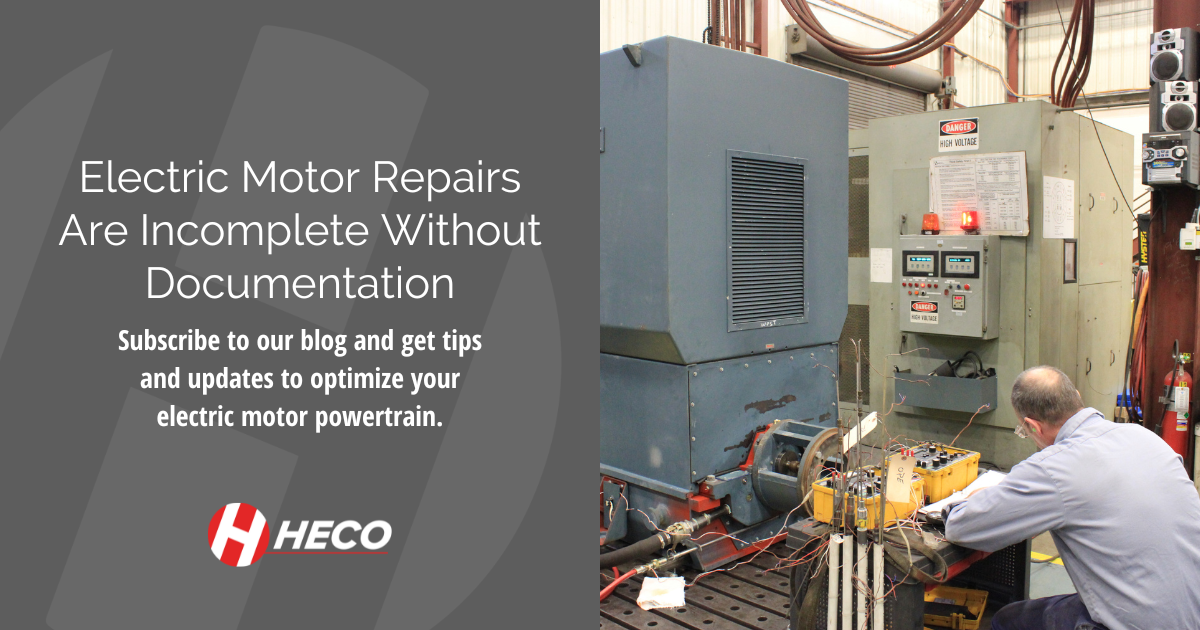Electric Motor Repairs Are Incomplete Without Documentation
September 19, 2024
When you send an electric motor out for repair, what information is provided? Does your vendor send a formal, written quotation showing all the items that need repair before they start working or do you just get a repaired motor back without any documentation or knowledge of what was done to it?
Once the motor has been repaired, do you receive a final report showing testing, measurements, and conditions of individual components of your motor or do you just get a repaired motor back with none of the information you paid for?
At HECO, we believe information is the key to ensuring your electric motors are reliable and efficient. Let’s discuss what you should expect from your electric motor repair vendor.
Figure Out What You Need To Know
It is becoming more and more difficult to convince upper management to make repairs or corrections without supporting information. With electric motors, what needs to be done is often less important than why it needs to be done in the first place. You must explain the “why” to upper management to get things done today.
So, what type of information should you be getting from your vendor? The answer depends on what you want and is often a balance between quality and quantity.
We have seen great one-page reports and great 20-page reports. In contrast, we have also seen terrible 100-page reports and terrible 2-page reports.
It’s important to start by figuring out what information you would like to see and what data will help you evaluate, maintain, and repair your equipment in the future.
Noting the motor’s full nameplate data is the bare minimum.
Incoming Data
Upon intake, pictures of the failure and overall motor condition should be documented as well as incoming findings. These incoming findings are used to complete a cause of failure analysis.
For comparison’s sake and validation of work, incoming as well as final test results should also be requested for:
- 1-minute insulation resistance to ground readings (including after cleaning).
- Polarization index.
- Surge comparison.
- Voltage drop (DC Motors).
- Hi-potential.
- Shaft current/endfloat/oil condition.
- Air gap readings.
- Rotor TIR runouts of all shaft surfaces.
- Voltage and current for all three phases (if ran on incoming).
- Vibration FFT spectrum and overalls (if ran on incoming).
After Repairs
Upon repair completion, pictures of the motor fully repaired and prepared for shipment are ideal along with readings from the final balance of the rotor and rotor assembly (with a fan or coupling).
All of the items that were tested or repaired according to the report should also tie back to the quotation or estimate you were provided and detail corresponding costs for correction. Between the report and this documentation of costs, you should know the full story behind what the condition of your motor was and why the specified components needed to be repaired.
Other Needs
Depending on your specific needs, critical machined fit readings may also be worth requesting before, during, and/or after repairs. Pictures of the motor throughout the repair process can also be helpful along with various other tests, measurements, etc. based on the machine’s characteristics and your application.
All Systems Go
If you aren’t being provided with complete and helpful documentation, talk with your electric motor repair vendor about your expectations and consider finding a new vendor, if necessary.
HECO can help you determine what data to collect, how to interpret equipment readings and trends, and even evaluate your vendor’s effectiveness. Contact us for assistance and insight to keep your electric motors running with maximum reliability.
Posted in Repair
